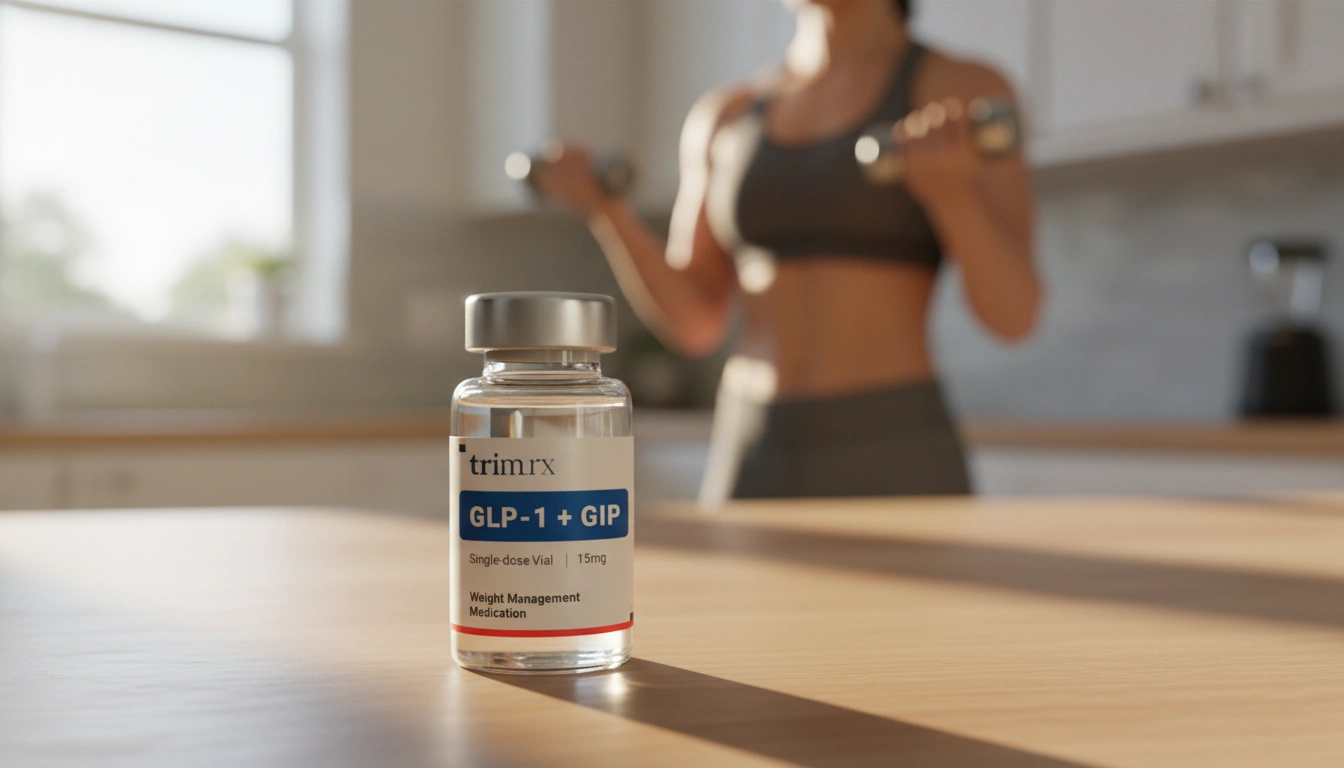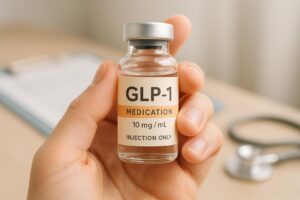How to Naturally Increase GLP-1 in Your Body for Better Health

Have you ever wondered why some foods leave you feeling full while others seem to trigger endless cravings? The secret might lie in a hormone called glucagon-like peptide-1 (GLP-1). Known for its critical role in regulating appetite and blood sugar levels, GLP-1 is a key player in maintaining metabolic health. In recent years, this hormone has gained attention for its potential benefits in weight loss and diabetes management, particularly with the rise of GLP-1 medications like semaglutide (Ozempic, Wegovy) and tirzepatide (Mounjaro, Zepbound). At TrimRx, we believe that understanding how to naturally boost GLP-1 can empower individuals to take charge of their health.
In this blog post, we will delve into what GLP-1 is, how it functions, and most importantly, how you can naturally increase its levels in your body through dietary and lifestyle choices. By the end of this article, you’ll have actionable tips to enhance your GLP-1 levels and promote better health and well-being.
Introduction
The significance of GLP-1 extends far beyond mere appetite control. This hormone, produced in the gut, is released after you eat, stimulating insulin secretion and slowing gastric emptying. In essence, it helps your body manage blood sugar levels while signaling satiety, which is crucial in preventing overeating. Interestingly, many of us may not be fully aware of this hormone’s impact on our daily lives until we start exploring weight loss or blood sugar management options.
Amidst the increasing popularity of GLP-1 medications, there’s a growing interest in how we can naturally enhance our body’s production of this vital hormone. The good news is that certain foods and lifestyle changes can promote GLP-1 secretion in ways that are both effective and sustainable.
In this post, we will cover the following topics:
- The role of GLP-1 in the body
- Foods that naturally increase GLP-1 levels
- The impact of exercise on GLP-1 production
- The importance of gut health for GLP-1 secretion
- Practical tips to incorporate GLP-1-boosting strategies into your daily routine
By exploring these areas, we aim to provide a comprehensive understanding of how to naturally increase GLP-1 in your body, allowing you to harness its benefits for better health.
Understanding GLP-1 and Its Functions
GLP-1 is a hormone that plays a multifaceted role in our metabolism. It is secreted by the L-cells in the intestinal lining and becomes activated when we consume food. Here are some of its primary functions:
-
Stimulates Insulin Secretion: GLP-1 enhances the secretion of insulin from the pancreas in response to meals, helping to lower blood sugar levels effectively.
-
Inhibits Glucagon Release: Glucagon is a hormone that raises blood sugar levels. GLP-1 inhibits its release, thereby contributing to better blood sugar control.
-
Slows Gastric Emptying: By slowing down the rate at which food leaves the stomach, GLP-1 helps maintain stable blood sugar levels and prolongs feelings of fullness.
-
Reduces Appetite: GLP-1 acts on the brain to regulate appetite, signaling when you’re full and reducing the desire to eat.
-
Promotes Weight Loss: By helping to regulate blood sugar and appetite, GLP-1 can support weight loss efforts, making it a focal point in obesity management.
Understanding these functions underscores the importance of maintaining healthy GLP-1 levels for overall metabolic health. With a clear grasp of its role, we can better appreciate the significance of boosting this hormone naturally.
Foods That Naturally Increase GLP-1 Levels
Diet plays a crucial role in stimulating GLP-1 production. Certain foods can enhance the secretion of this hormone, contributing to better appetite control and blood sugar regulation. Here are some categories of foods that you can incorporate into your diet:
1. High-Fiber Foods
Dietary fiber is one of the most effective ways to increase GLP-1 levels. Fiber-rich foods take longer to digest, which stimulates the release of GLP-1 and promotes feelings of fullness. Here are some excellent sources of dietary fiber:
-
Whole Grains: Foods such as oats, barley, and whole wheat are rich in soluble fiber, which has been linked to increased GLP-1 secretion.
-
Fruits and Vegetables: Apples, pears, carrots, Brussels sprouts, and other high-fiber fruits and vegetables can trigger GLP-1 release. These foods not only provide fiber but also essential vitamins and minerals.
-
Legumes: Beans, lentils, and peas are packed with fiber and protein, making them ideal for enhancing GLP-1 levels while keeping you satiated.
2. Healthy Fats
Certain types of fats can also stimulate GLP-1 secretion. Unsaturated fats, in particular, have been shown to be beneficial. Consider including the following sources in your diet:
-
Avocados: Rich in healthy fats and fiber, avocados are perfect for promoting GLP-1 and keeping you full.
-
Olive Oil: Extra virgin olive oil is an excellent source of unsaturated fats that can help increase GLP-1 levels.
-
Fish: Fatty fish, such as salmon and sardines, contain omega-3 fatty acids, which are known to support GLP-1 secretion.
3. Lean Proteins
Protein is another important nutrient for GLP-1 production. Incorporating lean sources of protein can help stimulate this hormone while aiding in appetite control. Examples include:
-
Eggs: Eggs are a fantastic source of protein and healthy fats, making them ideal for boosting GLP-1.
-
Poultry: Chicken and turkey are lean protein sources that can contribute to increased GLP-1 levels.
-
Plant-Based Proteins: Foods like tofu, beans, and lentils are excellent vegetarian protein sources that also provide fiber.
4. Fermentable Fibers
Certain types of fiber, known as fermentable fibers, play a specific role in GLP-1 secretion. These fibers are broken down by gut bacteria into short-chain fatty acids, which stimulate GLP-1 release. Foods rich in fermentable fibers include:
-
Barley: A great source of beta-glucan, a type of soluble fiber that can enhance GLP-1 production.
-
Oats: Like barley, oats are rich in soluble fiber and have been linked to increased GLP-1 levels.
-
Chia Seeds: These nutrient-dense seeds are high in fiber and can help promote satiety while supporting GLP-1 release.
The Impact of Exercise on GLP-1 Production
Exercise is another powerful tool for naturally boosting GLP-1 levels. Engaging in regular physical activity can enhance your body’s sensitivity to insulin and improve metabolic health. Here’s how exercise affects GLP-1:
-
Acute Exercise: Research indicates that a single bout of moderate to vigorous exercise can lead to an increase in GLP-1 levels. Activities like running, cycling, or high-intensity interval training (HIIT) can stimulate GLP-1 secretion.
-
Long-Term Benefits: Regular physical activity has been associated with improved insulin sensitivity and overall metabolic health, contributing to sustained GLP-1 production.
-
Combining Strength and Cardio: A balanced exercise routine that includes both cardiovascular workouts and resistance training can maximize the benefits of GLP-1 secretion.
Incorporating exercise into your daily routine not only supports GLP-1 levels but also enhances your overall well-being.
The Importance of Gut Health for GLP-1 Secretion
A healthy gut microbiome is essential for optimal GLP-1 production. The trillions of microorganisms residing in your gut influence how your body processes food and regulates hormones. Here are some key points to consider regarding gut health and GLP-1:
-
Prebiotics and Probiotics: Consuming prebiotic foods (which feed beneficial gut bacteria) and probiotic-rich foods (which introduce healthy bacteria) can enhance gut health and promote GLP-1 secretion. For prebiotics, focus on sources like garlic, onions, bananas, and asparagus.
-
Diversity Matters: A diverse gut microbiome is associated with better metabolic health and improved GLP-1 production. Aim for a varied diet rich in whole foods to support gut diversity.
-
Avoiding Processed Foods: Highly processed foods can disrupt gut health and negatively impact GLP-1 levels. Prioritize whole, unprocessed foods to maintain a healthy gut environment.
Practical Tips to Boost GLP-1 Naturally
Now that we’ve explored the various factors that influence GLP-1 levels, here are some practical tips to help you naturally increase this hormone:
-
Incorporate More Fiber: Aim to include a variety of high-fiber foods in your meals, such as whole grains, fruits, vegetables, and legumes.
-
Choose Healthy Fats: Opt for unsaturated fats from sources like avocados, nuts, and olive oil, while limiting saturated fats.
-
Prioritize Protein: Include lean protein sources in your diet to promote GLP-1 secretion and enhance satiety.
-
Stay Active: Engage in regular physical activity, combining both aerobic and strength-training exercises to maximize GLP-1 production.
-
Focus on Gut Health: Incorporate prebiotic and probiotic foods into your diet to support a healthy gut microbiome.
-
Practice Mindful Eating: Slow down during meals, savoring each bite to enhance your body’s natural satiety signals and promote GLP-1 release.
-
Hydrate: Staying adequately hydrated is essential for overall health and can aid in digestion, which may positively affect GLP-1 levels.
-
Consult with Professionals: If you’re considering dietary changes or weight loss strategies, consider taking our free assessment quiz at TrimRx to explore personalized weight loss programs that can help you on your journey.
By incorporating these strategies into your daily routine, you can create a supportive environment for GLP-1 production, leading to better appetite control and metabolic health.
Conclusion
Understanding how to naturally increase GLP-1 levels in your body can empower you to take charge of your health and well-being. By focusing on a diet rich in fiber, healthy fats, and lean proteins, along with regular exercise and a balanced gut microbiome, you can promote the secretion of this vital hormone.
At TrimRx, we are dedicated to helping individuals embrace healthier lifestyles through personalized weight loss solutions that align with their unique journeys. If you’re ready to explore how personalized care can support your weight loss goals and overall health, we invite you to take our free assessment quiz today. Together, let’s make sustainable weight loss attainable for you.
FAQ
What is GLP-1?
GLP-1 is a hormone produced in the gut that helps regulate blood sugar levels, appetite, and gastric emptying. It plays a crucial role in maintaining metabolic health.
How can I naturally increase GLP-1 levels?
You can naturally increase GLP-1 levels by consuming high-fiber foods, healthy fats, and lean proteins, engaging in regular exercise, and maintaining a healthy gut microbiome.
What foods are best for boosting GLP-1?
Foods that are high in fiber, such as whole grains, fruits, vegetables, legumes, and those rich in healthy fats like avocados and olive oil, are excellent for boosting GLP-1 levels.
Can exercise help increase GLP-1?
Yes, both acute and regular exercise have been shown to enhance GLP-1 levels, improving overall metabolic health.
Why is gut health important for GLP-1 production?
A healthy gut microbiome is essential for optimal GLP-1 production, as certain gut bacteria help stimulate its release. Eating prebiotics and probiotics can support gut health and, in turn, GLP-1 levels.
Incorporating these insights and practices into your life can significantly improve your overall health and weight management. Let’s embrace this journey towards better health together!

Transforming Lives, One Step at a Time
Keep reading
Tracking Progress With GLP-1: What To Measure
Learn which metrics to track on GLP‑1 therapy—weight, waist, blood sugar, lipids, side effects, and non‑scale wins—and how often to monitor them.
Fatigue Solutions for Ozempic and Wegovy Users
Hydration, protein-rich meals, light activity, and better sleep can reduce medication-related fatigue and help maintain energy during weight-loss treatment.
GLP-1 Medication Side Effect Checker
Worried about GLP-1 medication side effects? Use our free checker for Semaglutide, Liraglutide, and more to learn what to expect and stay informed!



